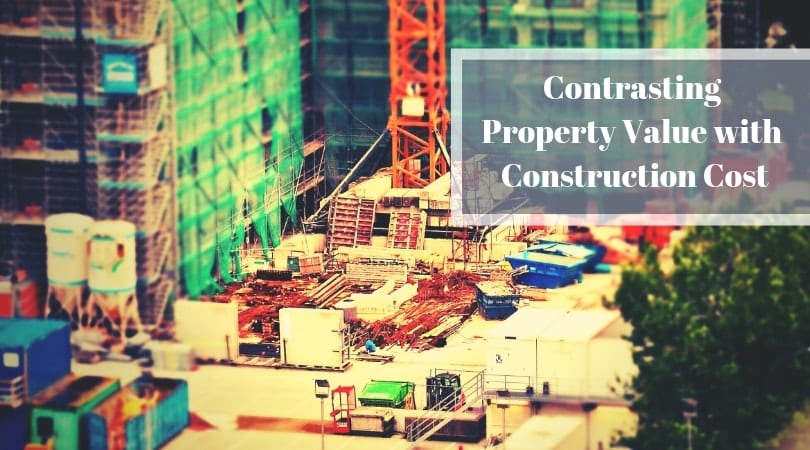Contrasting Property Value with Construction Cost: Untangling a Subtle but Critical Appraisal Complexity
Categories: Commercial Appraisals, Real Estate Appraisal, Real Estate Tips
The difference between construction cost and value is a central question in any appraisal assignment. Appraisers use several processes to estimate value. One of these is the cost approach, which takes into consideration the actual cost of building a structure similar or identical to the one under study. But other approaches to value often do not produce the same value estimate as simple as combining building cost and land value. Construction cost is an element of value, but it is not the same as value. An appraiser recognizes the difference and accounts for it in his value estimate. This difference is likely attributable to several causes that are identified and measured in market value appraisals.
Approaches to Value: No One Cap Fits All
Appraisers typically use three approaches to estimate value of real property. In the Sales Comparison Approach, an appraiser compares the subject property with similar properties that have recently sold. The Income Capitalization Approach relates an income-producing property’s potential net income to the price a buyer would likely pay for the property. In the Cost Approach, the appraiser estimates the property’s land value and adds to it the cost of constructing the existing improvements, while considering such enhancements’ age, condition, and usefulness.
There are limitations to all three approaches. When subject property is so unique that other properties can’t be compared to it, or when there have been no sales of similar properties, the Sales Comparison Approach is unreliable. If a property wouldn’t typically be purchased for its income generation, the Income Capitalization Approach is irrelevant. The Cost Approach has limited application if there aren’t enough identical land sales to estimate land value, or when the subject improvements are so specialized that construction costs can’t be effectively calculated. However, the Cost Approach does indicate whether a potential buyer might consider buying an existing improved property or lean towards building one.
Replacement Cost and Reproduction Cost
When estimating construction cost, appraisers can use one of two models: reproduction cost results in the cost of producing a replica of the subject building, using the same design and materials; replacement cost reflects the cost of producing a building of similar usefulness, based on current design and materials. An appraiser usually makes more adjustments to a reproduction cost estimate to account for differences in usefulness between older and newer buildings.
Appraisers rely on a variety of resources to calculate reproduction and replacement costs. Actual construction costs for subject or similar buildings can be the best basis for a cost estimate, adjusted for changed market conditions. Professional cost estimators and building contractors will occasionally provide cost estimates on a fee basis. Estimating services, such as the Marshall & Swift Valuation Service, offer up-to-date cost estimates for a variety of structure types, adjusted for location.
Depreciation in Appraisals
After developing a reasonable cost estimate, an appraiser must take into account how the subject building differs from a new structure. This difference is defined as the building’s depreciation. By estimating depreciation, the appraiser essentially shows why a building’s cost varies from its value. (NOTE: the term “depreciation” has different meanings in the appraisal and accounting professions.)
Several factors contribute to building depreciation. Physical deterioration describes the wear and tear a property has experienced; that’s why an appraiser considers a structure’s actual age versus its effective age. An especially well-maintained building might have a lower effective age than its actual age.
Functional obsolescence measures the ways the subject building varies from a new building that would serve the same purpose. For example, an older building might have thicker walls than needed or inadequate ceiling height: these are deficits that wouldn’t appear in a replacement building. Functional obsolescence is also seen in specialized structures built for specific users. Other users may have different needs and so would not pay for those special features.
The third element of depreciation is external obsolescence. This encompasses forces, independent of the subject property, that influence its value. They might include market demand, changing neighborhood character, and financing availability. External obsolescence explains why buildings that are voluntarily knocked down are more than those destroyed by sheer aging and dilapidation.
Conclusion
The cost approach is appropriate in many real estate appraisals. An important step in developing the cost approach is estimating reproduction or replacement cost of the property’s existing structure. But an equally important step is determining the building’s depreciation or calculating the difference between what it would cost to construct the building and the amount a buyer would pay for it. The difference is a consequence of the aging and wear the building has undergone, the building’s utility, and other conditions external to the building. When the appraiser deducts depreciation from the building’s cost, the property’s actual value is revealed. Except in the case of a perfectly designed new building that is in high demand, the building’s value will nearly always be different than its cost.





Keep up the great work! Thank you so much for sharing a great posts.
The facts that have been discussed here are really important. Thank you so much for sharing a great post.
I am glad to see that the cost and value of construction are a central question. I was afraid it was one of those things that everyone just accepts. My house is important so I’d like to be able to talk about cost over value with a contractor.